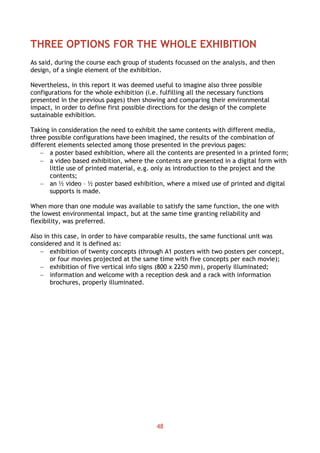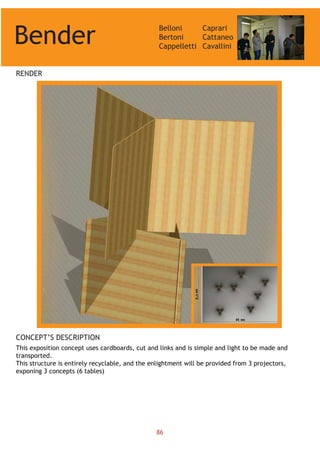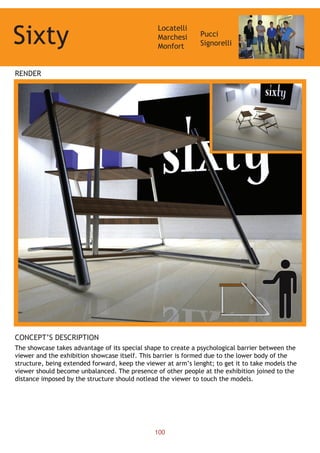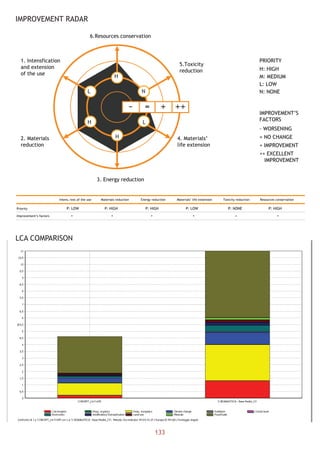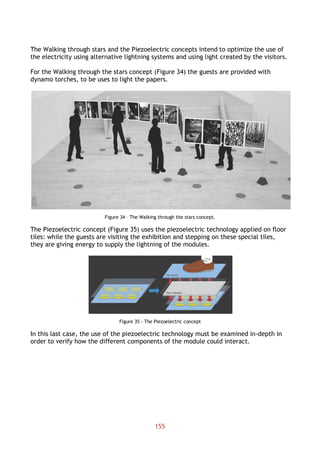The report outlines the outcomes of a course on environmental sustainability in design, part of the EU-funded TANGO project, taught by professors Carlo Vezzoli and Sara Cortesi. Students designed sustainable elements for a traveling exhibition, focusing on minimizing environmental impact using lifecycle assessment (LCA) methodologies. The course emphasizes integrating environmental priorities into design practices for industrial products, supported by various design methods and tools.
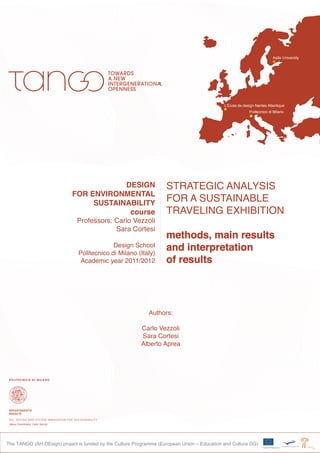










![11
COMPONENT MATERIAL
PP
7x frame tubes Aluminium
1x light tube Aluminium
6x “Padova” joints Reinforcing steel
2x bases OSB
4x bands Nylon
Nylon wire Nylon
2x panels Forex
8x “Tahuma” fixing systems Reinforcing steel
2x additional triangular supports Varnished OSB
4x A1 posters Paper
COMPONENT MANUFACTURING
P
7x frame tubes Extrusion
1x light tube Extrusion
6x “Padova” joints Extrusion
2x OSB bases [included in the material]
4x bands Extrusion
Nylon wire [included in the material]
2x panels [included in the material]
8x “Tahuma” fixing joints Mechanical manufacturing
2x additional triangular supports [included in the material]
4x A1 posters [included in the material]
MEANS OF TRANSPORT DISTANCE
DT
Heavy lorry
Milano – Helsinki – Nantes - Milano =
6384 km
FUNCTION PROCESS
U
Module lighting in Milan
Electricity (grid) for two 120W light bulb
switched on 10hrs/day, 7 days
Module lighting in Helsinki
Electricity (grid) for two 120W light bulb
switched on 10hrs/day, 21 days
Module lighting in Nantes
Electricity (grid) for two 120W light bulb
switched on 10hrs/day, 7 days
TREATMENTS
DP
Mix of recycle, incineration and landfill](https://image.slidesharecdn.com/tangoreport-130618082354-phpapp02/85/STRATEGIC-ANALYSIS-FOR-A-SUSTAINABLE-TRAVELING-EXHIBITION-12-320.jpg)

![13
COMPONENT MATERIAL
PP
8x frame tubes Aluminium
1x light tube Aluminium
10x “Frigerio” joints Aluminium
10x nuts and bolts sets Reinforcing steel
2x New Jersey bases HDPE
1x Lycra sheet Lycra
20x stocking clips (soft part) Rubber
20x stocking clips (hard part) Reinforcing steel
20x bands Nylon
11x Nylon wires Nylon
16x paperclips Reinforcing steel
4x A1 posters Paper
COMPONENT MANUFACTURING
P
8x frame tubes Extrusion
1x light tube Extrusion
10x “Frigerio” joints Dye casting
10x nuts and bolts sets Mechanical manufacturing
2x New Jersey bases Injection moulding
1x Lycra sheet Weaving
20x stocking clips (soft part) Injection moulding
20x stocking clips (hard part) Mechanical manufacturing
20x bands Injection moulding
11x nylon wires [included in the material]
16x paperclips Mechanical manufacturing
4x A1 posters [included in the material]
MEANS OF TRANSPORT DISTANCE
DT
Heavy lorry
Milano – Helsinki – Nantes - Milano =
6384 km
FUNCTION PROCESS
U
Module lighting in Milan
Electricity (grid) for two 120W light bulb
switched on 10hrs/day, 7 days
Module lighting in Helsinki
Electricity (grid) for two 120W light bulb
switched on 10hrs/day, 21 days
Module lighting in Nantes
Electricity (grid) for two 120W light bulb
switched on 10hrs/day, 7 days
TREATMENTS
DP
Mix of recycle, incineration and landfill](https://image.slidesharecdn.com/tangoreport-130618082354-phpapp02/85/STRATEGIC-ANALYSIS-FOR-A-SUSTAINABLE-TRAVELING-EXHIBITION-14-320.jpg)

![15
COMPONENT MATERIAL
PP
2x tubes Aluminium
1x recycled plastic base Aluminium
1x panel Reinforcing steel
4x bands Nylon
4x paperclips Steel
2x A1 posters Paper
COMPONENT MANUFACTURING
P
2x tubes Extrusion
1x recycled plastic base Injection moulding
1x panel [included in the material]
4x bands Injection moulding
4x paperclips Mechanical manufacturing
2x A1 posters [included in the material]
MEANS OF TRANSPORT DISTANCE
DT
Heavy lorry
Milano – Helsinki – Nantes - Milano =
6384 km
FUNCTION PROCESS
U
Module lighting in Milan
Electricity (grid) for one 120W light bulb
switched on 10hrs/day, 7 days
Module lighting in Helsinki
Electricity (grid) for one 120W light bulb
switched on 10hrs/day, 21 days
Module lighting in Nantes
Electricity (grid) for one 120W light bulb
switched on 10hrs/day, 7 days
TREATMENTS
DP
Mix of recycle, incineration and landfill](https://image.slidesharecdn.com/tangoreport-130618082354-phpapp02/85/STRATEGIC-ANALYSIS-FOR-A-SUSTAINABLE-TRAVELING-EXHIBITION-16-320.jpg)

![17
COMPONENT MATERIAL
PP
4x frame tubes Aluminium
4x L-shaped joints PVC
1x Lycra sheet Lycra
20x stocking clips (soft part) Rubber
20x stocking clips (hard part) Reinforcing steel
2m iron wire Iron
34x clamps Nylon
1x projector Various
1x laptop Various
COMPONENT MANUFACTURING
P
4x frame tubes Extrusion
4x L-shaped joints Injection moulding
1x Lycra sheet Weaving
20x stocking clips (soft part) Injection moulding
20x stocking clips (hard part) Mechanical manufacturing
2m iron wire Wire drawing
34x clamps Injection moulding
1x projector [included in the material]
1x laptop [included in the material]
MEANS OF TRANSPORT DISTANCE
DT
Heavy lorry
Milano – Helsinki – Nantes - Milano =
6384 km
FUNCTION PROCESS
U
Projection in Milano
Electricity (grid) for one 470W projector
switched on 10hrs/day, 7 days
Projection in Helsinki
Electricity (grid) for one 470W projector
switched on 10hrs/day, 21 days
Projection in Nantes
Electricity (grid) for one 470W projector
switched on 10hrs/day, 7 days
Laptop use in Milano
Electricity (grid) for one 50W laptop
switched on 10hrs/day, 7 days
Laptop use in Helsinki
Electricity (grid) for one 50W laptop
switched on 10hrs/day, 21 days
Laptop use in Nantes
Electricity (grid) for one 50W laptop
switched on 10hrs/day, 7 days
TREATMENTS
DP
Mix of recycle, incineration and landfill](https://image.slidesharecdn.com/tangoreport-130618082354-phpapp02/85/STRATEGIC-ANALYSIS-FOR-A-SUSTAINABLE-TRAVELING-EXHIBITION-18-320.jpg)
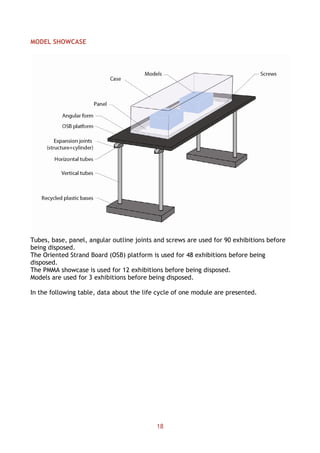
![19
COMPONENT MATERIAL
PP
1x OSB platform Varnished OSB
4x vertical tubes Aluminium
4x horizontal tubes Aluminium
2x recycled plastic bases Recycled PE
1x panel Dbond (Aluminium 70%, PE 30%)
1x angular form Aluminium
1x case PMMA
14x screws Reinforcing steel
2x expansion joints (structure) Low-alloyed steel
2x expansion joints (cylinder) Tetrafluoroethylene
2x models Polyurethane foam
COMPONENT MANUFACTURING
P
1x OSB platform [included in the material]
4x vertical tubes Extrusion
4x horizontal tubes Extrusion
2x recycled plastic bases Injection moulding
1x panel [included in the material]
1x angular form Extrusion
1x case [included in the material]
14x screws Mechanical manufacturing
2x expansion joints (structure) Extrusion
2x expansion joints (cylinder) Injection moulding
2x models [included in the material]
MEANS OF TRANSPORT DISTANCE
DT
Heavy lorry
Milano – Helsinki – Nantes - Milano =
6384 km
FUNCTION PROCESS
U
Module lighting in Milan
Electricity (grid) for one 120W light bulb
switched on 10hrs/day, 7 days
Module lighting in Helsinki
Electricity (grid) for one 120W light bulb
switched on 10hrs/day, 21 days
Module lighting in Nantes
Electricity (grid) for one 120W light bulb
switched on 10hrs/day, 7 days
TREATMENTS
DP
Mix of recycle, incineration and landfill](https://image.slidesharecdn.com/tangoreport-130618082354-phpapp02/85/STRATEGIC-ANALYSIS-FOR-A-SUSTAINABLE-TRAVELING-EXHIBITION-20-320.jpg)

![21
COMPONENT MATERIAL
PP
4x frame tubes Aluminium
2x joints, L-shaped PVC
2x joints, T-shaped PVC
1x supporting sheet PVC
2x tags Dbond (Aluminium 70%, PE 30%)
4x clamps Nylon
2x bases (internal covering) PVC
2x bases (body) Rubber
2m iron wire Steel
COMPONENT MANUFACTURING
P
4x frame tubes Extrusion
2x joints, L-shaped Injection moulding
2x joints, T-shaped Injection moulding
1x supporting sheet Extrusion
2x tags [included in the material]
2x bands Injection moulding
2x bases (internal covering) Injection moulding
2x bases (body) Injection moulding
2m iron wire Wire drawing
MEANS OF TRANSPORT DISTANCE
DT
Heavy lorry
Milano – Helsinki – Nantes - Milano =
6384 km
FUNCTION PROCESS
U
Module lighting in Milan
Electricity (grid) for one 120W light
bulb switched on 10hrs/day, 7 days
Module lighting in Helsinki
Electricity (grid) for one 120W light
bulb switched on 10hrs/day, 21 days
Module lighting in Nantes
Electricity (grid) for one 120W light
bulb switched on 10hrs/day, 7 days
TREATMENTS
DP
Mix of recycle, incineration and landfill](https://image.slidesharecdn.com/tangoreport-130618082354-phpapp02/85/STRATEGIC-ANALYSIS-FOR-A-SUSTAINABLE-TRAVELING-EXHIBITION-22-320.jpg)

![23
COMPONENT MATERIAL
PP
4x frame tubes Aluminium
2x joints, L-shaped PVC
2x joints, T-shaped PVC
1x supporting sheet PVC
2x tags Dbond (Aluminium 70%, PE 30%)
4x clamps Nylon
2x recycled plastic bases Recycled PE
COMPONENT MANUFACTURING
P
4x frame tubes Extrusion
2x joints, L-shaped Injection moulding
2x joints, T-shaped Injection moulding
1x supporting sheet Extrusion
2x tags [included in the material]
2x bands Injection moulding
2x recycled plastic bases Injection moulding
MEANS OF TRANSPORT DISTANCE
DT
Heavy lorry
Milano – Helsinki – Nantes - Milano =
6384 km
FUNCTION PROCESS
U
Module lighting in Milan
Electricity (grid) for one 120W light bulb
switched on 10hrs/day, 7 days
Module lighting in Helsinki
Electricity (grid) for one 120W light bulb
switched on 10hrs/day, 21 days
Module lighting in Nantes
Electricity (grid) for one 120W light bulb
switched on 10hrs/day, 7 days
TREATMENTS
DP
Mix of recycle, incineration and landfill](https://image.slidesharecdn.com/tangoreport-130618082354-phpapp02/85/STRATEGIC-ANALYSIS-FOR-A-SUSTAINABLE-TRAVELING-EXHIBITION-24-320.jpg)

![25
COMPONENT MATERIAL
PP
4x frame tubes Aluminium
2x joints, L-shaped PVC
2x joints, T-shaped PVC
1x supporting sheet PVC
2x tags Dbond (Aluminium 70%, PE 30%)
4x clamps Nylon
1x New Jersey base HDPE
COMPONENT MANUFACTURING
P
4x frame tubes Extrusion
2x joints, L-shaped Injection moulding
2x joints, T-shaped Injection moulding
1x supporting sheet Extrusion
2x tags [included in the material]
4x bands Injection moulding
1x New Jersey base Injection moulding
MEANS OF TRANSPORT DISTANCE
DT
Heavy lorry
Milano – Helsinki – Nantes - Milano =
6384 km
FUNCTION PROCESS
U
Module lighting in Milan
Electricity (grid) for one 120W light bulb
switched on 10hrs/day, 7 days
Module lighting in Helsinki
Electricity (grid) for one 120W light bulb
switched on 10hrs/day, 21 days
Module lighting in Nantes
Electricity (grid) for one 120W light bulb
switched on 10hrs/day, 7 days
TREATMENTS
DP
Mix of recycle, incineration and landfill](https://image.slidesharecdn.com/tangoreport-130618082354-phpapp02/85/STRATEGIC-ANALYSIS-FOR-A-SUSTAINABLE-TRAVELING-EXHIBITION-26-320.jpg)

![27
COMPONENT MATERIAL
PP
Desk woody parts Plywood
4x hinges Reinforcing steel
16x screws Reinforcing steel
8x pegs Beech
1x expositor structure Reinforcing steel
1x metal layer Reinforcing steel
1x base weight Reinforcing steel
2x nuts and bolts sets Reinforcing steel
2x clamps Nylon
COMPONENT MANUFACTURING
P
Desk woody parts [included in the material]
4x hinges Mechanical manufacturing
16x screws Mechanical manufacturing
8x pegs [included in the material]
1x expositor structure Mechanical manufacturing
1x metal layer Rolling
1x base weight Mechanical manufacturing
2x nuts and bolts sets Mechanical manufacturing
2x clamps Injection moulding
MEANS OF TRANSPORT DISTANCE
DT
Heavy lorry
Milano – Helsinki – Nantes – Milano =
6384 km
FUNCTION PROCESS
U
Module lighting in Milan
Electricity (grid) for one 100W light bulb
switched on 10hrs/day, 7 days
Module lighting in Helsinki
Electricity (grid) for one 100W light bulb
switched on 10hrs/day, 21 days
Module lighting in Nantes
Electricity (grid) for one 100W light bulb
switched on 10hrs/day, 7 days
TREATMENTS
DP
Mix of recycle, incineration and landfill](https://image.slidesharecdn.com/tangoreport-130618082354-phpapp02/85/STRATEGIC-ANALYSIS-FOR-A-SUSTAINABLE-TRAVELING-EXHIBITION-28-320.jpg)




















